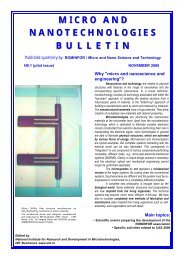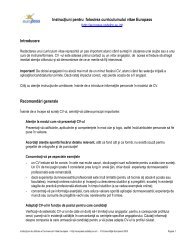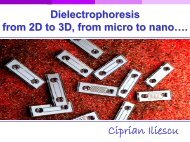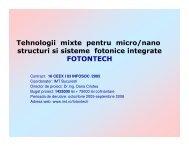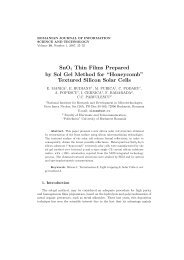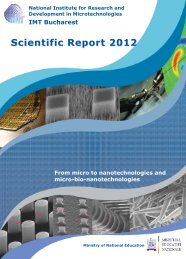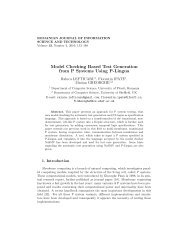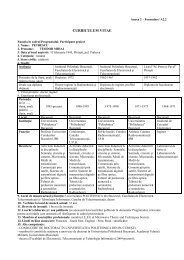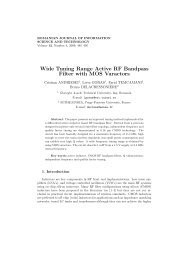Silicon Nitride Membrane for Cell Culturing - ResearchGate
Silicon Nitride Membrane for Cell Culturing - ResearchGate
Silicon Nitride Membrane for Cell Culturing - ResearchGate
You also want an ePaper? Increase the reach of your titles
YUMPU automatically turns print PDFs into web optimized ePapers that Google loves.
ROMANIAN JOURNAL OF INFORMATIONSCIENCE AND TECHNOLOGYVolume 11, Number 2, 2008, 167–176<strong>Silicon</strong> <strong>Nitride</strong> <strong>Membrane</strong><strong>for</strong> <strong>Cell</strong> <strong>Culturing</strong>C. ILIESCU, J. WEI, B. CHEN, P. L. ONGInstitute of Bioengineering and Nanotechnology,31 Biopolis Way, The Nanos, #04-01, Singapore 138669E-mail: ciliescu@ibn.a-star.edu.sgAbstract. This paper presents a development in producing low residualstress PECVD SiN x layers at high deposition rates and their application in cellculturing. The key factor in the novel process is the employment of up to 600 Whigh powers in high frequency (13.56 MHz). In conjunction with the adjustmentof the reactant gases composition, the residual stress can be tuned to 4 MPa andhigh deposition rate up to 320 nm/min can be achieved meanwhile. Moreover, byusing this optimized process, an 11 µm thick low stress SiN x layer was produced,which will be used to fabricate large area windows <strong>for</strong> cell culture. Finally, a cellculture test by cultivating mouse stem cells onto porous membrane by the lowstress PECVD SiN x layers also indicated that these layers are biocompatibleand are suitable <strong>for</strong> cell culturing.Key words: Low stress, silicon nitride, PECVD, high power, cell culturing.1. Introduction<strong>Silicon</strong> nitride (SiN x ) is one of the widely used materials in a variety of biomedicalimplant applications, due to its good chemical inertness, high fracture toughness, highwear resistance and biocompatibility [1, 2]. For example, it can be used as conductiveand dielectric layers, and selectively passivation layers against the in vitro and in vivoenvironments [3–5]; it also can be used in implantable microdevices and protein filtrationapplications as well-controlled, stable, uni<strong>for</strong>m membranes [6], which have severaladvantages compared to polymeric membranes, such as no morphological changeor degradability in biological fluids, adequate mechanical strength, and precisely
168 C. Iliescu et al.controlled pores features [7, 8]. All of these characteristics show that silicon nitrideis a promising material <strong>for</strong> biomedical applications.Currently, PECVD is one of the best methods to produce SiN x layers, due toits lower process temperature (usually around 300 ◦ C), and more uni<strong>for</strong>m and lessstress variation through wafers. However, one drawback <strong>for</strong> PECVD SiN x layers isthe high residual stress generated by PECVD standard processes, normally around120 Mpa. The high residual stress can greatly affect the membrane’s per<strong>for</strong>mance;<strong>for</strong> example, the high intrinsic stress will lead to stress-induced failure via microvoid<strong>for</strong>mation and structure [9, 10]; the wafers will break or be severely warped if thethickness is too large. On the other hand, <strong>for</strong> the biomedical applications, such as cellcultures, membrane with large areas and thick thickness is necessary, which meanslow stress is critical; otherwise, high stress inside the thick membrane will easily breakthe membrane, especially in the case of big exposed area.Here, we report a novel process to produce low stress PECVD SiN x layer and itsbiomedical applications. The developed process was able to produce near zero stressSiN x layers with a high deposition in a PECVD reactor. The developed process wasused to deposit thick SiN x layer and produced 11 µm layers with around 2.5 MPastress. These layers can be used to fabricate large area window which will be usedin cell culture experiments. Lastly, nanoporous membrane made by low stress SiN xwas generated and used <strong>for</strong> the cell cultures. By cultivating D1-CDFA cells on thenanoporous membrane, it is shown that the cells can grow well on top of the porousSiN x membrane and cells isolation results are satisfying.2. Experimental proceduresThe deposition of SiN x layers were carried out using a plasma-enhanced chemicalvapor deposition (PECVD) system (STS, Multiplex Pro-CVD). A schematic diagramof the equipment was presented by Chung et al in [11]. The unique characteristicof the system is that the plasma can be activated in two RF modes: at 380 kHz(LF) and/or at 13.56 MHz (HF). Another important characteristic of the equipmentis that it offers the opportunity of selecting the power in a large range: between 0and 600 W <strong>for</strong> HF mode and between 0 and 1 kW <strong>for</strong> LF mode. The depositionsof the layers were per<strong>for</strong>med using pure silane (SiH 4 ), ammonia (NH 3 ) and nitrogen(N 2 ). To avoid contamination of the deposited layer a predisposition of a SiN x layerwas per<strong>for</strong>med each time after the plasma cleaning process (usually per<strong>for</strong>med aftera cumulative deposition thickness of 6 µm).For characterization of the deposited layers 4 ′′ silicon wafers, p-type, < 100 >crystallographic orientation, 1–10 Ωcm were used. The wafer was initially cleanedin piranha (H 2 SO 4 : H 2 O 2 in the ratio of 2:1) at 120 ◦ C <strong>for</strong> 20 minutes, rinsed in DIwater and spun-dried. The native oxide of the layer was removed by dipping the wafer<strong>for</strong> one minute in a classical BOE solution. The stress characterization of the SiN xfilms was per<strong>for</strong>med with a stress measurement system (KLA Tencor FLX-2320). Thethickness of the films was measured with a refractometer (Filmetrics F50).
<strong>Silicon</strong> <strong>Nitride</strong> <strong>Membrane</strong> <strong>for</strong> <strong>Cell</strong> <strong>Culturing</strong> 1693. Fabrication process of low stress SiN x layers3.1. Deposition at high power in HF modeThe observation that in HF mode the tensile stress decreases with the RF powerwhile the deposition rate is significantly increased was further investigated. A series ofexperiments have been completed to deposit SiN x layer in the power range of 100 W to600 W. Figure 1 shows the variations of residual stress and deposition rate respectivelywith the power change. In these experiments, the pressure and temperature were setto be 900 mTorr and 300 ◦ C respectively while the reactant gas composition of SiH 4 /NH 3 / N 2 was 100/60/1500 sccm.Fig. 1. Variation of residual stress and deposition ratewith the power.From the graphs, it can be observed that, the deposition rate increases stronglywhile the residual stress decreases with the increase of power. That is because; theincreased energy of the electrons produced by higher power increases the dissociationof the main gases and as a result the deposition rate increases [12]. Moreover, thehigh dissociation rates of gases generated more N + species and consequently resultedin increased incorporation of N bonding in the SiN x film. This results in compressivestress due to the volume expansion of the SiN x film [13]. There<strong>for</strong>e, higher powerbrings higher compressive stress, which compensates the tensile stress and leads tooverall lower tensile stress. On the other hand, during the SiH 4 /NH 3 /N 2 process,the critical power to activate N 2 (9.8 eV) is much higher than that to activate NH 3(4.6 eV <strong>for</strong> H–NH 2 ) [14]. There<strong>for</strong>e, in the high power range (600 W), much more N 2have been activated and dissociated, which means more N atom will react with SiH 4and much more SiN x will be generated. That is to say, the decreasing stress value
170 C. Iliescu et al.with the increase of power can be attributed to the high dissociation of N 2 which ledto more N species and resulted in an increased of N–Si bonding in SiN x film.In a conclusion, the residual stress of SiN x layer decreases and the depositionrate increases with the increase of power. Moreover, the residual stress of siliconnitride layer deposited under the ultra high power condition (600 W) can reach a lowand high deposition rate were achieved simultaneously. There<strong>for</strong>e, in the followinginvestigations, all the powers were set to be constant to be 600 Watt.3.2. Influence of N 2 flow rateFrom above statement, it can be known the high RF power will “turn on” N 2during the deposition process, which means N 2 is a critical factor effecting SiN xresidual stress.Considering that N 2 supplies the N atom <strong>for</strong> reaction, the decrease of the N 2 flowrate will lead to “Si-rich” SiN x layer which has lower residual stress. In this part,the flow rates of nitrogen have been changed from 1150 sccm to 2200 sccm with thepower set to be constant at 600 W to investigate deposition rate and residual stress.The flow rates of SiH 4 and NH 3 were 120 sccm and 75 sccm, respectively, and thepressure was set to be 900 mTorr.Fig. 2. Variation of residual stress and deposition rateunder different N 2 flow rates.From the Fig. 2 it can be observed that the deposition rate increases and theresidual stress decreases as the N 2 flow rate decreases from 2200 sccm to 1150 sccm.The drastically decreasing N 2 flow (which is much higher than the NH 3 and SiH 4flows) has a huge impact decreasing the total gas flow rate (from 2395 to 1345 sccm).With the pressure constant, the residence time of the gas in the chamber increases.
<strong>Silicon</strong> <strong>Nitride</strong> <strong>Membrane</strong> <strong>for</strong> <strong>Cell</strong> <strong>Culturing</strong> 171A longer residence time results in a higher dissociated rate of ammonia in the plasmawith the effect of increasing of the deposition rate. Moreover, from the figure, thestress of the lowest N 2 flow rate was compressive (negative value).3.3. Influence of NH 3 flow rateIn order to investigate the relationship between residual stress / deposition ratesof SiN x layer with the NH 3 flow rate, the NH 3 flow rate was varied from 45 sccm to100 sccm with the SiH 4 and N 2 flow rate to be constant at 120 sccm and 2200 sccmrespectively. The pressure was 900 mTorr and the power was 600 W. The results wereshown in Fig. 3.Fig. 3. Variation of residual stress and deposition rateunder different NH3 flow rates.It can be seen that the deposition rate increased and residual stress decreased whenthe NH 3 flow rate decreases. This is because in ultra high power range, both SiH 4and NH 3 become activated, and when there is also sufficient excess NH 3 , almost allof the SiH 4 react with it to <strong>for</strong>m tetra-aminosilane, Si(NH 2 ) 4 , and the triaminosilaneradical, Si(NH 2 ) 3 . The latter is the dominant precursor species <strong>for</strong> film growth. Itdecomposes on the surface and in a “condensation zone” beneath the surface in aprocess whereby an NH 2 and an H from neighboring precursor radicals combine to<strong>for</strong>m an NH3 molecule, which is evolved into the plasma [15]. The resulting Si andN dangling bonds pull together to propagate the Si-N network, and this generate thetensile stress. On the other hand, low NH 3 flow rate will result in “Si-rich” SiNxlayer and the high silicon content yields lower stress level [16]. There<strong>for</strong>e, higher NH 3flow rate leads to higher tensile stress. The decreasing of the deposition rate with theincreasing of NH 3 flow rate can be explained by the cumulative effect of decreasing
172 C. Iliescu et al.the number of Si species in the plasma that generates also a decreasing of Si(NH 2 ) 3 –the film growth precursor. Similar results were achieved when the deposition powerwas changed. In addition Lee et al reported in [17] the decrease of the deposition ratewith the NH 3 /SiH 4 ratio.3.4. Influence of SiH 4 flow rateThe influence of SiH 4 flow rate is presented in Fig. 4. For this test, the SiH 4 flowrate was altered between 70 and 120 sccm, while NH 3 and N 2 were kept constantat 60 sccm and 1500 sccm. By increasing the SiH 4 flow rate, an increase numberof Si-based radials are generated in the plasma with the effect of increasing of thedeposition rate. In the mean time, the deposited SiN x layer will be “Si rich” and asa result the stress decreases with the increasing of SiH 4 flow rate. It can be notedthat with the increase of SiH 4 at 120sccm, the resultant stress in the layer is around13 MPa tensile, while the deposition rate increased up to 340 nm/min.Fig. 4. Variation of residual stress and deposition rateunder different SiH 4 flow rates.3.6. Fine tuning of SiN x residual stressAccording to the influences of reaction parameters to the SiN x residual stress, anoptimized recipe to produce low stress and high deposition rate has been generated.In this optimal recipe, a gas mixture SiH 4 /NH 3 /N 2 of 120/75/1200 sccm was usedand other conditions are: power 600 W, temperature 300 ◦ C and pressure 900 mTorr.The resultant stress was 4 MPa tensile and the deposition rate was 320 nm/min. Inthe following deposition process, this optimal recipe was employed.
<strong>Silicon</strong> <strong>Nitride</strong> <strong>Membrane</strong> <strong>for</strong> <strong>Cell</strong> <strong>Culturing</strong> 1734. Biomedical application of low stress silicon nitridemembranes4.1. Thick SiN x layer with low stressFor biomedical applications, a thick membrane is necessary <strong>for</strong> big surface and easy<strong>for</strong> manipulation to avoid diaphragm breakage during the cleaning and dicing process.There<strong>for</strong>e, a thick PECVD SiN x layer with low stress is promising <strong>for</strong> biomedicalapplications. By using the optimal recipe generated, an 11µm thick SiN x layer witharound 2.5MPa tensile stress was generated and the SEM picture of the SiN x layer ispresented in the Fig. 5.Fig. 5. The SEM picture of thick SiN x layer.By using the optimized recipe, nanoporous membrane with 400 nm pores size bylow stress SiN x layer was fabricated by the process shown in Fig. 6 and the SEMpicture of the porous membrane is shown as Fig. 7.4.2. Nanoporous membrane and cell culture testMoreover, the experiment to test the biocompatibility of the nanoporous SiN xmembrane in an in vitro cell attachment assay with the mouse D1 mesenchymal stemcells as the model cell line was completed. <strong>Cell</strong>s were stained with the cell trackerdye CFDA SE (Molecular Probes, Invitrogen) <strong>for</strong> easy visualization. Twenty-fourhours after cell seeding, cells were found to adhere strongly onto the nanoporousSiNx membrane, which can be seen from Fig. 8. The picture shows the mouse D1mesenchymal stem cells adopting a normal spread out morphology on the poroussupport.
174 C. Iliescu et al.Fig. 6. Fabrication process <strong>for</strong> the nanoporous membrane.(a. SiN x Deposition on the both sides; b. Feature patterned on the both sides;c. Single side KOH etching; d. Both side KOH etching; e. Adjust the holes)Fig. 7. The SEM picture of the nanoporous membranewith 400 nm pore size.
<strong>Silicon</strong> <strong>Nitride</strong> <strong>Membrane</strong> <strong>for</strong> <strong>Cell</strong> <strong>Culturing</strong> 175By using the nanoporous membrane fabricated by stress controlled silicon nitridemembrane, a micromachined membrane-based biocapsule with pore size precisely controlledcan be expected, which allows free exchange of nutrients, waste products, andsecreted therapeutic proteins between the host and encapsulated cells, but excludeslymphocytes and antibodies that may attack <strong>for</strong>eign cell. Microfabricated inorganicencapsulation devices by silicon nitride membrane may provide biocompatibility, invitro chemical and mechanical stability, tailored pore geometries, and superior immunoisolation<strong>for</strong> encapsulated cells over conventional encapsulation approaches. Byusing microfabrication techniques, structures can be fabricated with spatial featuresfrom the sub-micro range up to several millimeters. These multi-scale structurescorrespond well with hierarchical biological structure, from proteins and sub-cellularorganelles to the tissue and organ levels.Fig. 8. Mouse D1 mesenchymal stem cellswith the cell tracker dye CFDA SE.5. ConclusionsThis paper presented a new method <strong>for</strong> the fabrication of low stress SiN x layerin PECVD systems and its applications at fabrication of thick SiN x membranes,nanoporous membrane and cell culturing.References[1] NEUMANN A., RESKE T., HELD M., JAHNKE K., J. Mater. Sci.: Mater. Med., 15,p. 1135, 2004.
176 C. Iliescu et al.[2] CIARLO D. R., Biomed. Microdevices, 4(1), p. 63, 2000.[3] SANTINI JR. J. T., CIMA M. J., LANGER R., Nature, 397, p. 335, 1999.[4]HÄMMERLE H., KOBUCH K., KOHLER K., NISCH W., SACHS H., STELZLE M.,Biomaterials, 23, p. 797, 2002.[5] LI Y., et al., Controlled Rel., 100, p. 211, 2004.[6] DESAI T. A., et al., Biosensor & Bioelectronics, 15, p. 453, 2000.[7] LEONI L., DESAI T. A., Adv. Drug Del. Rev., 56, p. 221, 2004.[8] PRAKASH R. S., I. PhD Thesis, (UMI Dissertation Services), p. 80, 1994.[9] WINCHESTER K. J., DELL J. M., J. Micromech. Microeng., 11(5), p. 589, 2001.[10] MACHENZIE K. D., REELFS B., DEVRE M. W., WESTERMAN R., JOHNSON D.J., Characterization &, Unaxis USA, Inc, 2004.[11] CHUNG C. K., TSAI M. Q., TSAI P. H., LEE C., J. Micromech. Microeng., 15(1),p. 136, 2005.[12] SCHMID P., ORFERT M., VOGT M., Surf. Coating Technol., 98, p. 1510, 1998.[13] SMITH D. L., ALIMONDA A. S., VON PREISSIG F. J., J. Vac. Sci. Tech. B: Microel.,8, p. 551, 1990.[14] VOSSEN J. L., J. Electrochemical Society, 126, p. 319, 1979.[15] LEE J. Y. M., SOORIAKUMAR K., DANGE M. M., Thin Solid Films, 203, p. 275,1991.



